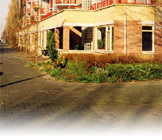|
|
|
|
Publications
|
|
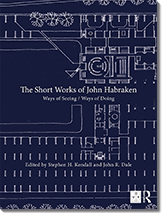 |
|
Edited By Stephen Kendall, John R. Dale:
The Short Works of John Habraken-
Ways of Seeing / Ways of Doing
Published March 31, 2023 by Routledge
ISBN 9780367820077
516 Pages 325 B/W Illustrations
This book offers, for the first time, access to the chronological arc of John HabrakenĄ¯s writing in a single collection.
Few architects or scholars have so consistently and patiently pursued such a humane and culturally vital set of radical questions related to the behaviour of the built environment as N. John Habraken. From the publication of his first book in 1960, he has quietly helped redraw the map of architectural research, education, practice, design methods and theory. His insights lead us to a better understanding of how the built field works, contributing to the development of methods enabling professionals to contribute to its coherence and resilience.
Following an introductory essay by the editors, placing HabrakenĄ¯s work in context, this collection is organized in two sections and further organized around a number of specific themes: The Built Field; Role of the Architect; Control; Sharing Forms; Examples of Ways of Doing; Open Building; Tools; and Cultivating the Built Environment. A series of interviews with the author enable him to reflect on his journey of inquiry, research, advocacy and teaching ¨C and the relationship between ways of seeing and ways of doing.
Offering theoretical perspectives and methodological ways forward, this book will be of interest to architects, planners and urban designers tackling the challenges of the contemporary built environment that Habraken identifies, as well as educators and students.
More information is available here.
|
|
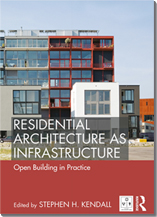 |
|
Stephen Kendall:
Residential Architecture as Infrastructure:
Open Building in Practice
Routledge, London, British, 2021
ISBN 9781003018339
408 Pages 210 B/W Illustrations
This edited collection provides an up-to-date account, by a group of well-informed and globally positioned authors, of recently implemented projects, public policies and business activities in Open Building around the world.
Countless residential Open Building projects have been built in a number of countries, some without knowledge of the original theory and methods. These projects differ in architectural style, building industry methods, economic system and social aims. National building standards and guidelines have been promulgated in several countries (Finland, China, Japan, Korea), providing incentives and guidance to Open Building implementation. Businesses in several countries have begun to deliver advanced FIT-OUT systems both for new construction and for retrofitting existing buildings, demonstrating the economic advantages of "the responsive, independent dwelling." This book also argues that the "open building" approach is essential for the reactivation of the existing building stock for long-term value, because in the end it costs less.
The book discusses these developments in residential architecture from the perspective of an infrastructure model of built environment. This model enables decision-makers to manage risk and uncertainty, while avoiding a number of problems often associated with large, fast-moving projects, such as separation and distribution of design tasks (and responsibility) and the ensuing boundary frictions.
Editorial Review quoted from Routledge Taylor & Francis Group
More information is available here.
|
|
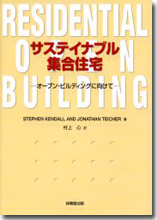 |
|
Stephen Kendall, Jonathan Teicher,
Shin Murakami (Translator):
Residential Open Building:
Japanese Edition
Gihodo Shuppan, Tokyo, Japan, 2006
ISBN 4-7655-2494-9
This book, " " in Japanese, is the Japanese edition of "Residential Open Building" written by Stephen Kendall and Jonathan Teicher. " in Japanese, is the Japanese edition of "Residential Open Building" written by Stephen Kendall and Jonathan Teicher.
It contains a list of 131 projects worldwide of which 26 are documented in more detail as case studies.
In addition the book gives an introduction in the underlying theories and methodology and a brief survey of economic approaches.
|
|
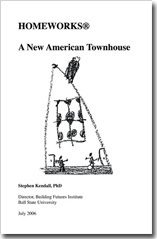 |
|
Stephen Kendall:
Homeworks®: A New American Townhouse
Trafford Publishing, Victoria, BC, Canada, 2006
ISBN 1-4120-9424-0
Homeworks® constitutes a natural evolution of the venerable wood frame housing tradition that dominates North American house building. Absence of a systemic rethinking of this tradition has meant that wood frame housing - as a building culture - has lagged behind other economic sectors in quality improvement, sensitivity to consumer preferences and sustainability. Whereas other sectors of the building industry are adopting a more rational and "change-ready" approach - internationally termed "open building" - wood frame housing remains mired in the obsolete concept of "whole-building integration". This inhibits innovation, prevents adoption of smarter labor practices, and produces a housing stock that will be a burden on future generations.
Homeworks® calls for a strict separation between the part of the house that should have a long life, and the part of the house that can be customized initially and adapt over time in response to changing household preferences and upgrades in consumer-sensitive technologies. These parts are called the "Shell" and the "Infil". The Shell is necessarily part of the local setting in all its physical, cultural, regulatory and environmental dimensions. The Shell helps make the urban scene. The Infill is not so constrained by the local scene. It is - and should increasingly be - approved by national certification agencies and distributed in the global marketplace of consumer-oriented products, "kits" and services. It responds more directly to the pulse of change, whereas the Shell is meant to age in place and become part of the social memory of an urban landscape.
Drawing on developments toward open building taking place internationally, and recognizing that changes to a way of building only happen incrementally and can only happen as a process of cultivation, Homeworks® offers principles that may help set the stage for a much needed maturation of wood frame house-building.
Editorial Review quoted from Trafford Publishing
More information is available here.
|
|
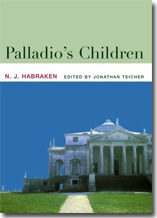 |
|
N. John Habraken and Jonathan Teicher:
Palladio's Children
Taylor & Francis, London, UK, 2005
ISBN 0-415-35791-8
Based on many years of personal observation, Habraken's important new book critically examines the role of the architect as a professional descendent of Palladio, and as an heir to his architectural legacy. Seven innovative and carefully crafted essays explore the widening ideological schism between today's architects whose core values, identity and education remain rooted in the Renaissance legacy of creating artful 'masterpieces', and the practical demands on a profession which acts within an evolving, ubiquitous and autonomous built environment or 'field'.
Clearly written yet expressing complex evolving ideas, this extended argument opens a new forum of debate across design theory, professional practice and academic issues. Moving the subject on from a historical perspective, Habraken shows how architects are increasingly involved in the design of everyday buildings. This must lead to a reassessment of architects' identities, values and education, and the contribution of the architect in the shaping ofthe built environment.
Editorial Review quoted from Amazon.com
More information is available at Professor Habraken's Website.
|
|
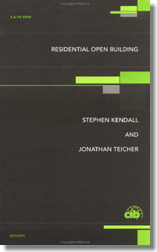 |
|
Stephen Kendall and Jonathan Teicher:
Residential Open Building
E & FN Spon, London and New York, 2000
ISBN 0-419-23830-1
This book is the most comprehensive report on the state of Open Building to date.
It contains a list of 131 projects worldwide of which 26 are documented in more detail as case studies.
In addition the book gives an introduction in the underlying theories and methodology and a brief survey of economic approaches.
N. John Habraken (www.habraken.org/)
Emeritus Professor, Massachusetts Institute of Technology
|
| | |
|
|













